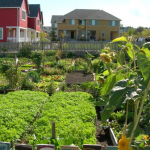Cohousing – designed for these times?
“Hardwoods throughout. Hand-painted Spanish tiling.” I read down the list of amenities for this 3-bed, 2.5-bath, $240,000 townhouse. “Installed wine cooler. Double shower. Organic farm.” Organic farm? Whoa, read again.
“Ecologically-minded, community-focused, and family-friendly, ours is an intentional community established in 2000. With 68 households, it is a real community where neighbors know each other, kids play together safely, and people and nature work together to create a peaceful habitat.”
 This is a cohousing community. There are over 200 of them listed in the cohousing directory – far more if you include ecovillages, urban housing cooperatives, intentional living, alternative communities, cooperative living, and other arrangements. I looked through the list to see how a cohousing community, planned from the start, might provide some of the resilience and self-reliance that many of us are trying to create retroactively in our neighborhoods. For instance:
This is a cohousing community. There are over 200 of them listed in the cohousing directory – far more if you include ecovillages, urban housing cooperatives, intentional living, alternative communities, cooperative living, and other arrangements. I looked through the list to see how a cohousing community, planned from the start, might provide some of the resilience and self-reliance that many of us are trying to create retroactively in our neighborhoods. For instance:
Lower heating/cooling costs Quite a few of the cohousing communities, like Ecovillage at Ithaca, NY, were built with energy conservation as a priority.
Reduced transportation fuel costs: Walkscores on six of the properties ranged from Southside Park in Sacramento at 83 (Very walkable) to Nubanusit in Peterborough, NH at 18 (Car dependent), although the latter does include office and studio space.
Increased food security: Most cohousing groups have some vegetable garden plots available, to provide “1-5% of residents’ food needs.” East Lake Commons in Atlanta includes a three-acre separately-farmed CSA (“6-20%”).
Access to jobs: Many cohousing communities lie in urban settings with a surprising number, like Delaware Street Commons in Lawrence, KS, in college towns, a bonus for job security.
Shared costs and skills: With maintenance and yard work often done by the community, weekly community meals, an emphasis on childcaring and eldercaring, a community workshop and playground, the chance to share transportation, and unusually neighborly neighbors, I can imagine cost savings left and right.
Check the cohousing and intentional community directories. Some regions offer multi-community tours. Cohousing is not for everyone. But with economic, environmental, and social pressures building, members of these communities are in a better position than most of us to navigate financial and lifestyle dangers.



